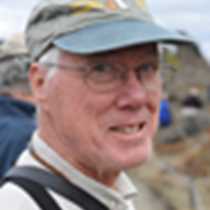The Midriff Region of the Gulf of California
A day with fin whales before breakfast is sure to be a good day! Never mind that Expedition Leader Larry Prussin’s artfully crafted plan for the day was quickly shattered by the combination of winds and marine mammals. Fin whales are the second largest of baleen whales – of all animals – of all animals known to have lived, second only to the giant blue whales that we saw earlier in our trip. “Finners” are also the fastest swimming of the whales, but Captain Graves was able to adjust our speed and course to match the steady progress of the whales, giving us superb views. We could see their identifying characteristics: the narrow, torpedo-shaped body; prominent fin set well back from the blowholes; and pattern asymmetry: white on the right side of the face, dark gray on the left side.
Shortly after breakfast the ship slowed again for another marine mammal encounter; this time a group of short-finned pilot whales. They are highly social, living in groups of up to fifty or so. Adult males, as seen above, are identified by the very large, strongly curved dorsal fin. The large bulbous “melon” on the head of pilot whales serves to focus the sounds that they use both in communications within the group and in locating their prey by echolocation. The combination of sensitive ship handling and the apparent curiosity of these toothed whales had them milling about and circling the ship, to our considerable glee.
Necessity brings new opportunities. We sought a spot for afternoon activities that was protected from the north wind, and we found a site new to our collective experience at Bahia Las Animas on the Baja California Peninsula. It provided easy walking on an outwash plain braided by the action of water rushing down from the mountains during the infrequent but sometimes severe rains. The effects of winter rains were evident in the flowering of desert plants that gave a splash of color to this austere but captivating landscape.
A day with fin whales before breakfast is sure to be a good day! Never mind that Expedition Leader Larry Prussin’s artfully crafted plan for the day was quickly shattered by the combination of winds and marine mammals. Fin whales are the second largest of baleen whales – of all animals – of all animals known to have lived, second only to the giant blue whales that we saw earlier in our trip. “Finners” are also the fastest swimming of the whales, but Captain Graves was able to adjust our speed and course to match the steady progress of the whales, giving us superb views. We could see their identifying characteristics: the narrow, torpedo-shaped body; prominent fin set well back from the blowholes; and pattern asymmetry: white on the right side of the face, dark gray on the left side.
Shortly after breakfast the ship slowed again for another marine mammal encounter; this time a group of short-finned pilot whales. They are highly social, living in groups of up to fifty or so. Adult males, as seen above, are identified by the very large, strongly curved dorsal fin. The large bulbous “melon” on the head of pilot whales serves to focus the sounds that they use both in communications within the group and in locating their prey by echolocation. The combination of sensitive ship handling and the apparent curiosity of these toothed whales had them milling about and circling the ship, to our considerable glee.
Necessity brings new opportunities. We sought a spot for afternoon activities that was protected from the north wind, and we found a site new to our collective experience at Bahia Las Animas on the Baja California Peninsula. It provided easy walking on an outwash plain braided by the action of water rushing down from the mountains during the infrequent but sometimes severe rains. The effects of winter rains were evident in the flowering of desert plants that gave a splash of color to this austere but captivating landscape.




